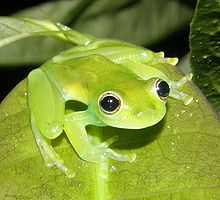Teratohyla spinosa
| Teratohyla spinosa | |
|---|---|
 | |
| Conservation status | |
| Scientific classification | |
| Kingdom: | Animalia |
| Phylum: | Chordata |
| Class: | Amphibia |
| Order: | Anura |
| Family: | Centrolenidae |
| Genus: | Teratohyla |
| Species: | T. spinosa |
| Binomial name | |
| Teratohyla spinosa (Taylor, 1949) | |
| Synonyms | |
|
Centrolenella spinosa Taylor, 1949 | |
Teratohyla spinosa (common name: spiny Cochran frog) is a species of frog in the Centrolenidae family. It is found in Colombia, Costa Rica, Ecuador, Honduras, Panama, and Nicaragua.[1][2]
Teratohyla spinosa inhabits lowland primary humid lowland forests. It is found along streams in the low vegetation. Its habitat is threatened by deforestation, although the species is not considered threatened in view of its wide distribution and presumed large population.[1]
Teratohyla spinosa are small, green frogs with large, protuberant eyes. Males grow to a snout–vent length of 18–20 mm (0.71–0.79 in) and females to 20–23 mm (0.79–0.91 in). Tadpoles are 16 mm (0.63 in) in length when metamorphosing.[3]
Males call throughout the wet season (May–October) from the low vegetation surrounding small streams. Females lay 18–25 eggs on the underside of vegetation in a single layer of loose jelly.[3] Larvae develop in streams.[1]
References

- ↑ 1.0 1.1 1.2 1.3 Coloma, L. A. et al. (2010). "Teratohyla spinosa". IUCN Red List of Threatened Species. Version 2013.2. International Union for Conservation of Nature. Retrieved 29 March 2014.
- ↑ Frost, Darrel R. (2014). "Teratohyla spinosa (Taylor, 1949)". Amphibian Species of the World: an Online Reference. Version 6.0. American Museum of Natural History. Retrieved 29 March 2014.
- ↑ 3.0 3.1 "Teratohyla spinosa". AmphibiaWeb: Information on amphibian biology and conservation. [web application]. Berkeley, California: AmphibiaWeb. 2014. Retrieved 29 March 2014.
